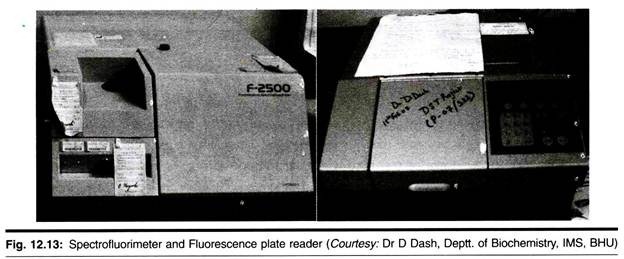ADVERTISEMENTS:
Let us make an in-depth study of the role of RNAs in gene regulation. After reading this article you will learn about: 1. Antisense RNA 2. RNA Interference (RNAi) 3. Micro RNAs and 4. Ribozyme Technology.
Introduction:
Recent researches have made remarkable discovery that RNA plays a vital and wide role in controlling the gene expression and gene regulation. Remarkable structural and functional diversity of RNA molecules have been discovered. These are non-coding RNAs and offer powerful gene silencing pathways. The wide role that RNA plays has opened the door for fighting cancers, deadly viruses and other pathogens, without any side effects. RNA can make RNA-RNA, RNA-DNA complexes which can control the expression of genes.
Any harmful gene can be inactivated or knocked-out using RNA technology. Much progress has been made in developing therapeutics for destroying pathogenic mRNA.
Antisense RNA:
ADVERTISEMENTS:
An antisense RNA is an RNA strand that is complementary to the mRNA strand. It may bind to RNA to form RNA-RNA duplex structure. The translation of mRNA is inhibited by binding to antisense RNA which is complementary to mRNA. It may cause degradation of mRNA. In this way translation of mRNA is prevented. This is known as post transcriptional gene silencing. This offers a powerful technology tool for turning off genes or silencing genes at will. It has also been discovered that antisense RNA can also prevent transcription of genes.
Antisense RNA is produced by reversing the orientation of a gene with regards to its promoter so that antisense strand is transcribed.
RNA Interference (RNAi):
Double stranded RNAs (ds RNAs) play a major role in selective destruction of mRNAs which have the same sequence as the ds RNAs. This leads to selective inhibition of gene expression. It is called RNA interference or RNAi. Many plant viruses have double stranded RNAs with sequences similar to genes of the plant cell. They inhibit the expression of similar genes in plant cell.
ADVERTISEMENTS:
ADVERTISEMENTS:
Inside the cell the double stranded RNA is first cleaved by a ribonuclease called Dicer, into small double stranded fragments of 21-23 nucleotides. These are known as small interfering RNAs (Si RNAs). One strand of SiRNA is destroyed and its antisense strand is
taken up by an enzyme called RNA induced silencing complex (RISC) to destroy the corresponding mRNA.
This blocks the synthesis of proteins. In this way it inhibits the translation of mRNA or they can move into the nucleus where they cause chromatin modification. Proteins encoded by other mRNAs are not affected. This is a powerful technology tool which can selectively silence any gene.
In human beings, mRNAs transcribed from the viral genome or from the mutant oncogenes can be destroyed using RNA interfering technology, while at the same time not affecting any other mRNAs of the cell.
Antisense technology offers a technique for inactivating a single chosen gene. Scientists recently have developed a new class of drugs called antisense drugs which can block the genes like oncogenes, associated with the production of harmful proteins.
Antisense therapy is showing promise against one of the greatest killers, tuberculosis. It has been discovered that antisense RNA can target Mycobacterium tuberculosis genes. Aegis Therapeutics, a drug company have developed an antisense drug that can be administered orally.
1. Application of antisense technology in plant genetic engineering.
Slow ripening of tomatoes:
Transgenic tomatoes have been developed which contain antisense strands of poly-galactouronase gene. These inhibite the expression of gene and produce less PG enzyme. This causes slow ripening of tomatoes, thus improving their shelf life.
ADVERTISEMENTS:
2. Modification of flower colour of decorative flowers.
Antisense RNA has also been discovered to play a role in osmoregulation in bacteria and maintain internal cell volume.
Micro RNAs:
Another class of small RNAs has been discovered both in plants and animals called micro RNAs (mi RNAs). They are also 21-23 nucleotides long like siRNAs. While an siRNA is derived from double stranded RNA, the miRNA is encoded by transcription of normal genes by RNA polymerase. The miRNA also target and inhibit a particular gene. Human beings are thought to produce numerous micro RNAs.
The phenomenon of antisense RNA inhibition is widespread in eukaryotes and probably evolved to protect the organisms from foreign or rogue genetic material like the immune system of our body.
Ribozyme Technology:
ADVERTISEMENTS:
Earlier all enzymes were thought to be proteins. In 1990 Tom Cech and Sidney Altman won Nobel Prize for their discovery that RNA could act as an enzyme. Ribozymes are antisense RNA molecules with enzymatic properties. Ribozymes bind to the target RNA by cleaving phosphodiester backbone at a specific site. Five classes of ribozymes have been described.
Of these, hammer-headed ribozyme and hairpin ribozymes have shown considerable potential therapeutic value. They inhibit viral gene expression and particularly inhibit viral replication of HI V-RNAs.
A ribozyme has two binding sites — a substrate binding site and a guanosine binding site. Ribozymes are antisense RNA molecules with enzymatic properties.

